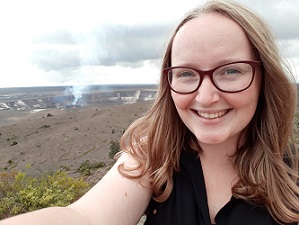Dr Claire Harnett, Ad Astra Fellow and Assistant Professor at UCD’s School of Earth Sciences

Can you describe your research?
Primarily I'm a volcanologist, and mainly do numerical modelling of different volcanic environments, normally focusing on large scale stability. I'm particularly interested in how we can look at volcanic rock properties and implement more accurate representations of those properties into numerical models to try to obtain a better approximation of hazard and volcanic stability as a whole.
When it comes to volcanic hazards, a lot of research has been done into eruptive hazards, trying to work out what conditions change in a volcano to make it erupt. One area that needs further exploration is the topic of volcanic stability - For example, when a volcano is erupting, there are a lot of opposing forces such as pressure from the magma reservoir and downward gravitational driving forces. One of the things that can happen is that there is instability at the flanks of the volcano. And we don't know that much about what triggers that instability. So, my research primarily looks at trying to work out what conditions can trigger volcanic instabilities and relating different triggering mechanisms to different types and sizes of instability and hazard.
What led you to pursuing geology as a career?
At school, as part of my A levels (a UK equivalent of the Irish Leaving Certificate), I chose geography and I really liked its physical aspects. That got me interested in hazards in general. Later, I chose an applied geological hazards degree and discovered my love of geology by accident. I'm not what you might consider to be a traditional field geologist - my passion lies in how we can use the latest numerical modelling approaches to better understand the geology around us. I also love research and geology has so many varied topics that are being researched all the time. For me, the main attraction of geology is how varied the applications are and how it brings together a bunch of different fundamental sciences in an applied way.
We are your typical day-to-day activities?
In a typical week, I teach on a variety of modules. Some are an introduction to geology and different types of rocks, and some are more engineering focused, looking at how geology affects different structures. For example, if you want to build a tunnel, how would you go about that, how would you do that when different types of rocks are involved? Some of my week is taken up with research, and for that I do a lot of numerical modelling, which involves creating a digital environment that is similar to a volcanic environment in real life, and then seeing what factors we can play around with in that model to explore different scientific questions. This involves mostly coding and programming knowledge. I am also involved in laboratory characterization of rocks. We have a big compression machine where we can squash rocks and work out how strong they are to get information that we can then incorporate into our numerical models. The rest of my week typically comprises other activities like supervising students, communicating my science inside and outside of academia, and working on the issues facing the University and the geosciences on a bigger scale.
What’s your favourite aspect of being a geologist?
I think my favourite thing about being a geologist is the way that we can apply the more traditional sciences to a subject that is relevant to our daily lives. When a bridge collapses or a landslide disrupts a railway line, those things are often rooted fundamentally in geology.